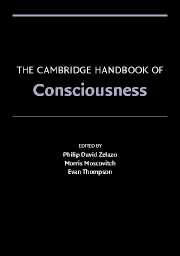Crossref Citations
This Book has been
cited by the following publications. This list is generated based on data provided by Crossref.
Marcovitch, Stuart
Jacques, Sophie
Boseovski, Janet J.
and
Zelazo, Philip David
2008.
Self‐Reflection and the Cognitive Control of Behavior: Implications for Learning.
Mind, Brain, and Education,
Vol. 2,
Issue. 3,
p.
136.
Armezzani, Maria
2009.
How to Understand Consciousness: The Strength of the Phenomenological Method.
World Futures,
Vol. 65,
Issue. 2,
p.
101.
2009.
The Neuropsychology of Mental Illness.
p.
389.
Marcovitch, Stuart
and
Zelazo, Philip David
2009.
The need for reflection in theories of executive function: reply to commentaries.
Developmental Science,
Vol. 12,
Issue. 1,
p.
24.
Low, Jason
2010.
Preschoolers’ Implicit and Explicit False‐Belief Understanding: Relations With Complex Syntactical Mastery.
Child Development,
Vol. 81,
Issue. 2,
p.
597.
PATTARO, ENRICO
2010.
I Will Tell You about Axel Hägerström: His Ontology and Theory of Judgment.
Ratio Juris,
Vol. 23,
Issue. 1,
p.
123.
Linger, Daniel T.
2010.
What Is It Like to Be Someone Else?.
Ethos,
Vol. 38,
Issue. 2,
p.
205.
Lewis, Michael
2010.
The Handbook of Life‐Span Development.
Jack, Vandermeulen
2011.
Tweeluik hersenen: wat dan nog?.
Neuropraxis,
Vol. 15,
Issue. 3,
p.
85.
Rochat, Philippe
2011.
Early Development of Body Representations.
p.
3.
Sheets-Johnstone, Maxine
2012.
Knowing without Thinking.
p.
187.
de Villiers, Peter A.
and
de Villiers, Jill G.
2012.
Deception dissociates from false belief reasoning in deaf children: Implications for the implicit versus explicit theory of mind distinction.
British Journal of Developmental Psychology,
Vol. 30,
Issue. 1,
p.
188.
Lycan, William G.
2012.
The Cambridge Handbook of Cognitive Science.
Bartlett, Gary
2012.
The Oxford Companion to Consciousness.
Philosophical Psychology,
Vol. 25,
Issue. 3,
p.
451.
Low, Jason
and
Simpson, Samantha
2012.
Effects of Labeling on Preschoolers’ Explicit False Belief Performance: Outcomes of Cognitive Flexibility or Inhibitory Control?.
Child Development,
Vol. 83,
Issue. 3,
p.
1072.
Breivik, Gunnar
2013.
Zombie-Like or Superconscious? A Phenomenological and Conceptual Analysis of Consciousness in Elite Sport.
Journal of the Philosophy of Sport,
Vol. 40,
Issue. 1,
p.
85.
Lancaster, Brian
2015.
Hermeneutic Neurophenomenology in the Science-Religion Dialogue: Analysis of States of Consciousness in the Zohar.
Religions,
Vol. 6,
Issue. 1,
p.
146.
Rochat, Philippe
2016.
Developmental Psychopathology.
p.
1.
Jao, Tun
Li, Chia-Wei
Vértes, Petra E.
Wu, Changwei Wesley
Achard, Sophie
Hsieh, Chao-Hsien
Liou, Chien-Hui
Chen, Jyh-Horng
and
Bullmore, Edward T.
2016.
Large-Scale Functional Brain Network Reorganization During Taoist Meditation.
Brain Connectivity,
Vol. 6,
Issue. 1,
p.
9.
2017.
Introducing Contemplative Studies.
p.
321.



